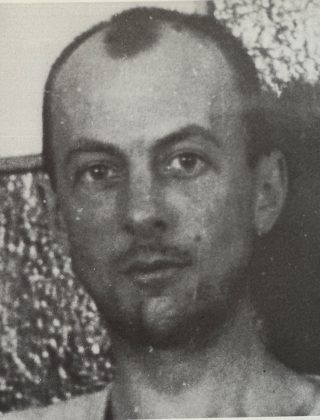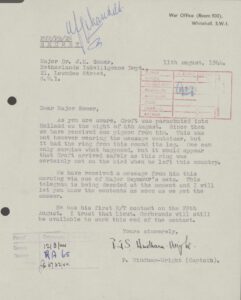Ger van der Weerd, the long road to freedom

During WW2 an engineer from the Dutch KLM airlines flees the occupied Netherlands to go to Britain and work for room 900 of MI9. He is trained to become a spy. In August 1944 he is parachuted back into the Netherlands, where he works together with different resistance groups to set up pilot escape lines. Ger gets help from his future wife Tineke, a resistance fighter.
This is his story.
3rd story of the England Voyagers of the Royal Dutch Airlines
Ger, living in Rotterdam, the Netherlands, was 26 years old and worked as an aeronautical engineer at KLM airlines. When the war broke out in the Netherlands in May 1940 Schiphol and a huge part of KLM’s fleet was bombed. Ger was out of a job and got temporarily stationed at an airplane factory. Ger van der Weerd knew immediately he wanted to leave the country and go to Britain, from where he wanted to fight against the Nazis.
The Dutch, who escaped the occupied Netherlands with the intention to go the England or another allied country, to join the allied forces to the fight against the enemy, were the so called Engelandvaarders (England Voyagers). They took different escape routes, over sea, land and air.
It was not easy to leave the occupied country. The most popular routes over land were the Northern route through Sweden and the Southern route, which went through Spain, Portugal or Switzerland.
ESCAPE FROM THE NETHERLANDS
In November 1940 Ger applied for a job as boat engineer at the coaster ‘Franka’. The boat was supposed to sail to Sweden and Ger thought it would be a perfect opportunity to try to get off in Sweden and continue his journey to Britain from there. The boat captain was a fierce German, who got a suspicious about Ger and continuously kept an eye on him. Meanwhile the ship got into a storm and was forced to change course. It was incredibly cold, minus 26 degrees and the ship got frozen in the Baltic Sea. The condition on board was horrific, the toilets had broken down and it was not possible to go outside because of the freezing cold. The crew wasn’t sure they would make it, but luckily a Danish icebreaker rescued them and they returned to Rotterdam. Once on shore the German intelligence service, Sicherheitsdienst (SD) arrested Ger. They were contacted by the captain, who thought Ger was planning on going to England. The SD interrogated Ger about his plans to find out if he wanted to go through Sweden to England. Ger denied and told them, that the KLM offered him a job at Curacao, where the KLM still flew. Finally, the SD believed his story and he was released.
Back in the Netherlands the KLM helped him to get a job as office clerk at the Central service for import and export. In this position he travelled throughout the country and he used this opportunity to gather information about the German’s war production (metal), which he sent to a friend who worked for the resistance. As time passed Ger became even more eager to get to England. He wasn’t free in the Netherlands. He decided to make another attempt, but this time he wanted to go through Spain.
Ger dressed up as an office clerk, wearing a suit, a coat and hat. He wanted to be as inconspicuous as possible. He only brought a few extra socks, a loose collar for his shirt, shaving gear and some money. He did not say goodbye to his parents, he didn’t want them to worry too much. He took the train from Rotterdam to Maastricht, where he blended in with the crowd that crossed the border to Belgium. He pretended it would be just another day in the office. He did the same thing the day after when crossing the Belgium-French border. He knew a few people in France, where he stayed overnight. Ger managed to get on the employers list of a Dutch company ‘Bosland-Wynberge’, that also worked for Germans. The company gave him German papers, which indicated he worked for an airfield in Marseille and the letter ordered people to help him with food or other necessities while travelling. Ger made it to Marseille safely. From there he wanted to continue his journey to Spain. He was told it wasn’t safe to cross the Pyrenees on his own and he should hire a guide, which cost 12.000 francs. He decided to go on his own anyway, he believed that you would draw more attention being with someone and when you’re on your own you can make all the decisions. He walked through wine fields, where he ate some grapes and figs and walked through thorn bushes, cause he didn’t want to walk on roads. His clothes were completely torn. He arrived at a farm, it was too dangerous to stay the night, but he drank a few glasses of water and moved on. He spent the nights in the Pyrenees in the pouring rain, sleeping on rock plateaus. Ten days after leaving the Netherlands he finally arrived in Spain. Here he was captured and locked up in the concentration camp Miranda de Ebro for months, where he had to survive under very difficult circumstances. A Jewish trader in southern fruits, named Davids, helped many Dutch young men to get out of imprisonment. So finally, after months Ger got out and continued his journey to Britain.
Once in Britain he endured the interrogations of the Battersea School, the Royal Patriotic School and the Dutch intelligence service. He also met with the Dutch Queen Wilhelmina in London, like all the other England Voyagers. Ger was recruited by room 900 of MI9 and unknowingly became Trix Terwindt’s successor.
Room 900 gave him the following assignment:
Your mission is to contact useful people in Holland and form an organisations for the evacuation of British and American Service personnel who have evaded capture on the Continent, or have escaped from Germany. For this purpose you have been trained in R/T, whereby you will be able to keep in touch with London.
Ger had one condition to become an MI9 agent, he wanted to work fully solo. He didn’t want to be welcomed by any committee upon arrival in the Netherlands, nor did he want it to be announced when he would arrive. They did know he was coming, but had no idea when or where he would stay.
At the police school in Hendon Ger learnt parachute jumping, coding, hearing techniques and cover stories. The physical training was tough. He got 8 identity checks, in case he needed to warn the British in case he would fall in German hands. Ger got different codenames, like Wentworth and Croft. MI9 told him, that a cover story should never be 100% solid, cause that would attract suspicion.
RETURN TO HOLLAND
Every person, that would be parachuted back into the Netherlands was offered a dinner with chocolates before leaving. Many times Ger was supposed to be sent to the Netherlands and due to the weather and operational failures they had to call the parachute drop off last minute. In the end Ger enjoyed twenty dinners before his parachute drop finally succeeded on 4th of August 1944. At half past midnight he parachuted down in the occupied Netherlands.
The Brits weren’t aware that a week before the villa ‘De Valkenhorst’ were Ger was supposed to land had been confiscated by the Germans and now served as their radio station and was severely guarded. Ger was spotted by a German guard while he glided through the air with his parachute. Ger could hear the guard yell “Da komt einer” (‘There’s one’). Ger dropped his legbag mid-air, which contained his radio equipment. He almost landed on top of a German guard. He had to hide quickly and first buried his bag, which contained 220.000 guilders in a ditch. And then he hit under leaves and bushes. The Germans gathered and circled around, anxious to find him, they kept shooting around and a few times they almost stepped on Ger’s hand. Ger had to lay still for 5 hours while they were searching for him. Ger had a cardboard box strapped around his body with two carrier pigeons. Despite the fact he couldn’t see much due to the poor moonlight he managed to scribble a short message, tied it to the pigeons’ legs and released them. One of the pigeons reached London safely so MI9 knew Ger had arrived in the Netherlands.
 It became light again and the German guards decided to get the Sicherheidsdienst. Ger used the opportunity to hit his revolver in a pile of pine needles and took of his camouflage uniform. He was wearing civilian clothes underneath, and pretended to be an innocent walker from the area. He arrived at a farm and luckily the farmer and his wife weren’t pro German. They hit is bag with money in a haystack. When he left the farm he could hear the Germans coming towards the farm. He walked to Eindhoven and took a train to Rotterdam. He travelled as an employer of the Central service for import and export, like he did at the beginning of the war too.
It became light again and the German guards decided to get the Sicherheidsdienst. Ger used the opportunity to hit his revolver in a pile of pine needles and took of his camouflage uniform. He was wearing civilian clothes underneath, and pretended to be an innocent walker from the area. He arrived at a farm and luckily the farmer and his wife weren’t pro German. They hit is bag with money in a haystack. When he left the farm he could hear the Germans coming towards the farm. He walked to Eindhoven and took a train to Rotterdam. He travelled as an employer of the Central service for import and export, like he did at the beginning of the war too.
A few weeks later after his parachute drop he went back to the area to collect his revolver and bag. In the weeks after he worked with different resistance groups to set up a pilot escape lines. He also gathered important information for the allied. Ger worked closely with the Raad van Verzet (Council of Resistance), which served as an umbrella organisation for different resistance groups.
He also worked with Tineke (Albertine de Koning), to whom he would marry at the end of the war. Tineke was a resistance fighter, she delivered weapons for resistance fighters, she carried them with her on trains, where she was surrounded by Dutch members of the Socialist parties.
In September 1944 operation Market Garden took place. Thousands of allied forces parachuted down in the Netherlands. And after a heroic battle at the bridge Rijnbrug in Arnhem the British forces had to bring themselves in safety. Not all of them managed to cross the Rhine and a few hundred British military stayed behind. Ger played an important role to help them to return to Britain by using the pilot escape lines he had set up the weeks prior to the Market Garden operation. They were supported by resistance fighters from Arnhem, Bennekom, Ede and Lunteren.
Ger got awarded the British King’s Medal for Courage in the Cause of Freedom, the Americam Medal of Freedom and the Dutch Bronzen Kruis, 2 Kruis van Verdiensten, het Verzetsherdenkingskruis and the Oorlogs herinneringskruis.
Photos by book ‘Oranjehaven’en het Nationaal Archief
Published by Their Story. Contact me at info@their-story.org
Share this: